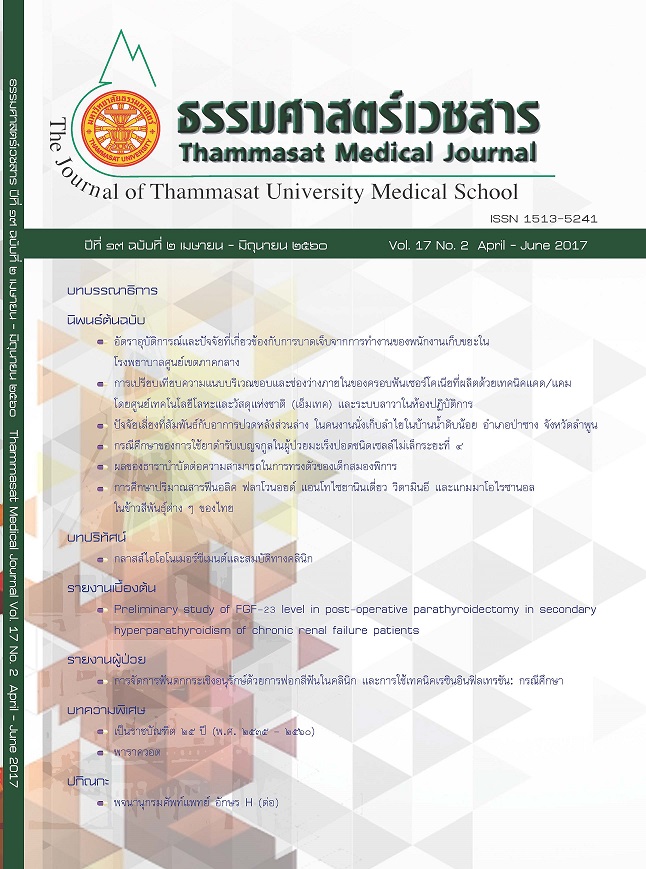Preliminary study of FGF-23 level in post-operative parathyroidectomy in secondary hyperparathyroidism of chronic renal failure patients
Keywords:
End Stage Renal Disease (ESRD), Secondary hyperparathyroidism, Parathyroidectomy, Fibroblast growth factor 23 (FGF-23), ไตวายเรื้อรังระยะสุดท้าย, การผ่าตัดต่อมพาราไทรอยด์Abstract
Introduction: Secondary hyperparathyroidism is a common complication in patients with the end stage renal disease (ESRD), accelerated by hyperphosphatemia. Fibroblast growth factor 23 (FGF-23) has emerged as an important phosphorus-regulating protein for renal phosphate wasting disorders. In ESRD patients, FGF-23 levels are raised with declining kidney function. Objective was to determine and correlate the levels of circulating FGF-23, phosphate, and calcium after total parathyroidectomy in secondary hyperparathyroidism of chronic renal failure patients.
Method: Thirty patients with marked secondary hyperparathyroidism were enrolled. All patients were underwent total parathyroidectomy accompanied by the implantation and their FGF-23 levels were measured at 0, 10, 20, 30, and 40 minutes after parathyroidectomy by means of ELISA
assays. Biochemical data including the result of calcium (Ca), phosphate (PO4), and parathyroid hormone (PTH) were collected from medical records.
Result: FGF-23 levels were significantly decreased at 20 minutes after total parathyroidectomy (p < 0.05). FGF-23 levels were significantly correlated with PO4, (ρ= 0.64, p < 0.05) Ca (ρ= 0.51, p < 0.05), and PTH (ρ= 0.90, p < 0.05) levels. The complete removal of enlarged parathyroid glands significantly reduced circulating FGF-23 levels at 20 minutes. In addition, FGF-23 correlated positively with serum PO4, Ca, and PTH values in secondary hyperparathyroidism in chronic renal failure patients.
Discussion and Conclusion: Circulating FGF-23 levels may early reflect alterations in ongoing PTH and phosphate balance in patients. Therefore, FGF-23 may be used as the predictive marker for monitoring the successful treatment secondary hyperparathyroidism in chronic renal failure patients.
บทนำ: Secondary hyperparathyroidism เป็นภาวะแทรกซ้อนที่พบได้บ่อยในผู้ป่วยไตวายระยะสุดท้าย เนื่องจากผู้ป่วยมีปัญหาเรื่องการควบคุมระดับฟอสเฟตในเลือด ทำให้เกิดการขับฟอสเฟตออกจากร่างกายได้น้อยลงส่งผลทำให้มีภาวะฟอสเฟตในเลือดสูง fibroblast growth factor 23 (FGF-23) จึงมีบทบาทสำคัญในการควบคุมระดับฟอสเฟตในผู้ป่วย ทั้งนี้ในผู้ป่วยไตวายเรื้อรังระยะสุดท้าย ระดับ FGF-23 จึงเพิ่มขึ้นพร้อมกับการทำงานของไตที่ลดลง วัตถุประสงค์เพื่อศึกษาระดับและความสัมพันธ์ระหว่างระดับ fibroblast growth factor 23 (FGF-23) ฟอสเฟตและแคลเซียมในเลือดของผู้ป่วยไตวายเรื้อรังระยะสุดท้ายที่มีภาวะ secondary hyperparathyroidism ภายหลังได้รับการผ่าตัดต่อมพาราไทรอยด์ออก ณ เวลาที่ต่างกัน
วิธีการศึกษา: ผู้ป่วยไตวายเรื้อรังระยะสุดท้ายที่มีภาวะ secondary hyperparathyroidism จำนวน ๓๐ ราย เข้ารับการผ่าตัดต่อมพาราไทรอยด์ด้วยวิธี total parathyroidectomy ทำการตรวจหาระดับ FGF-23 โดยวิธี ELISA ภายหลังการผ่าตัดต่อพาราไทรอยด์เป็นช่วงเวลา ๐, ๑๐, ๒๐, ๓๐ และ ๔๐ นาที พร้อมกับเก็บข้อมูลผลการทดสอบทางห้องปฏิบัติการ ได้แก่ ระดับพาราไทรอยด์ฮอร์โมน แคลเซียม และฟอสเฟต ตามช่วงเวลาที่กำหนด
ผลการศึกษา: ระดับ FGF-23 ลดลงอย่างมีนัยสำคัญ (p < ๐.๐๕) ที่เวลา ๒๐ นาทีหลังจากผ่าตัดต่อมพาราไทรอยด์ และระดับ FGF-23 แสดงค่าความสัมพันธ์เชิงบวกกับระดับฟอสเฟต (ρ = ๐.๖๔, p < ๐.๐๕) แคลเซียม (ρ = ๐.๕๑, p < ๐.๐๕) และฮอร์โมนพาราไทรอยด์ (ρ = ๐.๙๐, p < ๐.๐๕) อย่างมีนัยสำคัญ ที่เวลา ๒๐ นาทีภายหลังการผ่าตัด
วิจารณ์ และสรุปผลการศึกษา: จากผลการศึกษานี้พบว่าระดับ FGF-23 จะมีการเปลี่ยนแปลงและสะท้อนถึงสมดุลพาราไทรอยด์ฮอร์โมนและฟอสเฟตของผู้ป่วยหลังการผ่าตัดต่อมพาราไทรอยด์ได้ ดังนั้นระดับ FGF-23 อาจสามารถใช้เป็นตัวบ่งชี้ที่มีประโยชน์กับแพทย์ในการพยากรณ์โรคและตรวจติดตามในการรักษาผู้ป่วยที่ได้รับการรักษาด้วยการผ่าตัดต่อมพาราไทรอยด์



